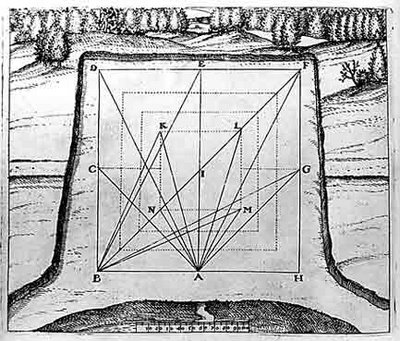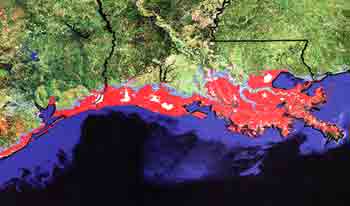 [Images: Raytheon’s flying antenna-blimp (via Defense Tech), and an “11.2-kilometer tunnel [being dug] through a mountain more than 2,400 meters high in Central Ecuador”/ENR].
[Images: Raytheon’s flying antenna-blimp (via Defense Tech), and an “11.2-kilometer tunnel [being dug] through a mountain more than 2,400 meters high in Central Ecuador”/ENR].
Raytheon is working on “a radar antenna that spans the length of a football field.” Even better, it flies: “The airship, remaining essentially motionless, could hover for long periods above the jet stream at altitudes of 65,000 to 70,000 feet, with the antenna transmitting on UHF and X-band.”
Going in the opposite direction, a German firm is drilling one of the deepest tunnels in the world – though it is also one of the highest. The tunnel is simultaneously “under more than 900 meters of earth” and “more than 2,400 meters high,” passing through the mountains of central Ecuador. As Engineering News-Record reports, the geology is immensely complicated there and the tunnel has already collapsed twice; it is part of a much larger hydroelectric power scheme for the Ecuadorian Andes.
Fascinatingly, to secure loose rubble inside the tunnel – including cracks in the walls and ceiling – the project engineers “inject” the mountain “with resins and foam to consolidate the mass and stabilize it.”
So what new veins of weird geology will Andean hikers stumble upon in a few ten million years…?
 [Image: The tunnel’s route/ENR].
[Image: The tunnel’s route/ENR].
Another tunnel back in the news is NYC’s City Tunnel No. 3, explored several months ago on BLDGBLOG, and photographed beautifully by Stanley Greenberg.
 [Image: City Tunnel no. 3; photo by Sewell Chan/New York Times].
[Image: City Tunnel no. 3; photo by Sewell Chan/New York Times].
Meanwhile, Japan is working on a 30-year weather forecast via the Earth Simulator – not an Amsterdam-based performance artist but one of the world’s fastest supercomputers. The Earth Simulator “occupies a warehouse the size of four tennis courts in Tokyo,” and scientists want to use it “to map the routes taken by typhoons, heatwaves and droughts, and potentially spare millions from death and disease.”
Then there’s this near-perfectly arranged photograph – of GWB speaking on an empty airport tarmac – which rewards sustained analysis. The transnationally geometric infrastructure of power:
 [Image: From the NYTimes – though I now can’t find the article].
[Image: From the NYTimes – though I now can’t find the article].
On the other hand, here is the geometry of war:
The mathematicians of the Renaissance applied their geometry to all manner of practical disciplines – from navigation and surveying to cartography and perspective. They aimed to demonstrate the usefulness of geometry as well as its ingenuity and certainty, and to associate it with action, achievement and progress. Many new instruments were designed in this context, as the collections of this museum amply demonstrate.
 [Image: “A system of fortification and its protagonist.” Courtesy of the Museum of the History of Science, Oxford].
[Image: “A system of fortification and its protagonist.” Courtesy of the Museum of the History of Science, Oxford].
Developments in the art of warfare in the late 15th and 16th centuries provided another outlet for geometry, and the mathematicians were quick to respond by devising techniques, designing instruments and writing books. Heavy guns manufactured in single metal castings were longer, capable of more accurate fire, and were adjustable in elevation. Consequently, gunners needed instruments to measure both the inclination of the barrel and the distance to the target, together with a means of relating these two measurements. Geometers offered a variety of solutions to these problems, as well as designs for fortifications to withstand attack from the new artillery.
Emphasis mine. Here is a list of images – but don’t miss the elevated fortress or this spiky precursor to the Pentagon.
 [Image: A geometrical town survey; courtesy Museum of the History of Science. (Via)].
[Image: A geometrical town survey; courtesy Museum of the History of Science. (Via)].
Finally, as this was meant to be a quick list… 1) The earth’s volcanoes are singing: “High-powered computers are being used to convert seismic readings from Mount Etna in Sicily and Tungurahua in Ecuador into audible rumbles, roars, beeps, and even piano music. The technique, known as ‘sonification’, is used to help people detect patterns in complex data.” 2) The United States is being genetically en-golf-coursed by “creeping bentgrass,” a genetically-modified grass immune to commercial pesticides; it was designed to make golf courses easier to maintain and more lush underfoot. Now it will destroy you. 3) The unexpectedly impressive landscape architecture firm EDAW wants the Los Angeles River to include “a Class I bicycle path in and along the Arroyo Seco Channel between the communities of Highland Park and Cypress Park.” EDAW’s Gulf Coast Mapping Study is also well worth a look (here’s a PDF).
 [Image: “The red areas, including New Orleans, lie less than four feet above sea level and could be threatened by storm surges, flooding , and rising sea levels.” Courtesy EDAW].
[Image: “The red areas, including New Orleans, lie less than four feet above sea level and could be threatened by storm surges, flooding , and rising sea levels.” Courtesy EDAW].
4) This is great – Dennis Dollens uses “Bio-observation and Software Growth as an approach to conceptualize and demonstrate growing architectural elements such as canopies and columns.” Via WorldChanging. 5) This is ridiculous.
(Earlier: Quick list 1).
The spiky fortifications are designed so a gunner or archer inside the fort can get a clean line of sight across the facing wall, thus defending against siege.
The old-style four-wall tower had a vulnerability at the corners, since the walls were so thick that no one on the inside could safely defend them. Pull up a siege machine and start chipping away in relative safety.
I like how your 16th century example includes the guy making the elevator pitch in the drawing.